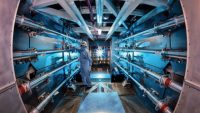Nuclear-Fusion Breakthrough Points to Clean Energy Future
December 19, 2022
The U.S. Department of Energy announced that that scientists at a federal research facility have achieved a breakthrough in nuclear fusion that advances the quest to unlock an unlimited energy source. The development, which took place at the Lawrence Livermore National Laboratory in California, was decades in the making, and paves the way for advancements in national defense and the future of clean power. Marking a first, the team at Livermore’s multi-billion dollar National Ignition Facility achieved “scientific energy breakeven,” producing more energy from fusion than the laser energy used to drive it.
Calling the milestone unprecedented, Secretary of Energy Jennifer Granholm said, “This is what it looks like for America to lead, and we’re just getting started,” adding that the breakthrough “will go down in the history books,” according to The Wall Street Journal.

Since the NIF opened its doors in 2009, “the goal of a fusion reaction that produces a net gain of energy — a key step toward transforming fusion into a practical source of energy — had eluded scientists,” notes WSJ.
“This astonishing scientific advance puts us on the precipice of a future no longer reliant on fossil fuels but instead powered by new clean fusion energy,” Senate Majority Leader Chuck Schumer said in a statement adding the University of Rochester’s Lab for Laser Energetics in New York to the list of those contributing to the achievement.
Schumer also said he’s helped secure as part of the National Defense Authorization Act more than $624 million this year “to build on this amazing breakthrough.”
WSJ provides thrilling insight into the science involved: using 192 laser beams fired into a gold cylinder that contained “a peppercorn-size capsule containing the fuel needed for a nuclear-fusion reaction — a partially frozen mixture of two hydrogen isotopes, deuterium and tritium.”
As they entered the cylinder, the laser beams created X-rays that launched “a rapid implosion that superheated and crushed the fuel capsule to the width of a human hair,” WSJ explains, noting, “those extreme temperatures and pressures —like those in the cores of stars and giant planets and in exploding nuclear weapons — triggered a fusion reaction.”
Researchers say commercial applications for fusion “likely remains years, if not decades, away,” WSJ writes, detailing in a separate article the new businesses that are already gearing up around it.
“It’s a lot to take in,” notes The Verge, which compiled a Guide to Fusion Power. “Once humans figure out how to make nuclear fusion happen in a controlled way, the possibilities are endless. “Hydrogen is the simplest and most abundant element in the universe. You can get it from seawater, for example. And if you do, a single gallon of seawater can generate as much energy as 300 gallons of gasoline.”

No Comments Yet
You can be the first to comment!
Sorry, comments for this entry are closed at this time.